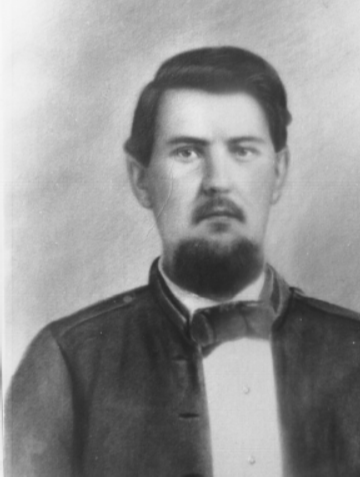
In Honor of My Great-Grandfather....
Veteran of the War for Southern Independence

Pvt. William G. Farthing
The first Company Muster Roll that gives the enlistment date was for four months pay and reported he had enlisted in Pittsylvania County, Virginia the 28 of Aug 1861 for 1 yr. by Capt. Penick.
He had enisted into the 53rd. Regiment Virginia Infantry. This company was
formerly Captain Penick's Company, Montague's Battalion, Virginia Infantry.
The 53rd Regiment Virginia Infantry was organized December 1, 1861, by the
consolidation of Montague's and Tomlin's Battalions and Waddill's Company Virginia Infantry. It was reorganized
in May 1862, and men of the 5th Battalion Virginia Infantry, who were of conscript age, were transferred to it
by S.O. No. 200, A. & I. G.O., dated September 6 1862.
General Pickett was in front about 300 yards ahead of the artillery position,
and to the left of it, and some 200 yards behind the command which was then at the stone wall over which some of
the men were going, that is, the 53rd Regiment, part of Armistead's Brigade, led by Colonel Rawley Martin, who
fell next to the gallant General Armistead, reached the enemy's guns and captured them.
William was released from Point Lookout by Government Order No. 109, A. G.
O. On his discharge papers he was described as being light complected with sandy coloured hair, blue eyes and standing
5 feet, 9 3/4 inches tall.
Point Lookout POW Camp (Camp Hoffman) was established after the Battle of Gettysburg
to incarcerate Confederate prisoners. It was in operation from August 1863 through June 1865. Being only 5' above
sea level, it was located on approx. 30 acres of leveled land at the southern tip of Maryland, in St. Mary's County,
and surrounded by water on three sides by the Chesapeake Bay and Potomac River. It was the largest prison camp
in the north.
Before the war, Point Lookout was a fashionable resort hotel and a summer bathing
place with over a hundred cottages where the elite spent their leisure time. In 1862, with erection of additional
buildings, it became a military hospital for the care of union soldiers, as well as a supply depot for the Army
of the Potomac. In August 1863, the large building with outbuildings arranged in spoke fashion (Hammond Hospital),
became the care center for wounded/sick Confederate prisoners as well as for union men.
During the two year span of operation, Point Lookout saw approx.
50,000 POWs pass through her gates. These were military and civilian, men and women, black and white. It's also
interesting to note that the youngest POW at Point Lookout was Baby Perkins. He was born there. His mother was
captured at the Battle of Spotyslvania with her artillery unit.
Prison conditions were deplorable. Rations were below minimal causing scurvy
and malnutrition. Prisoners ate rats and raw fish. It's recorded that one hungry Rebel devoured a raw seagull that
had been washed ashore. Soap skim and trash peelings were often eaten when found. Lice, disease, and chronic diarrhea
often resulted in an infectious death. Prisoners were deprived of adequate clothing, often no shoes in winter or
a blanket among sixteen or more housed in old, worn, torn sibley tents. Even the Point's weather played havoc with
the prisoners. Because of it's location, it's extremely cold with icy wind in the winter and a smoldering sun reflecting
off the barren sand in summer was blinding. High water often flooded the tents in the camp area. The undrained
marshes bred mosquitoes. Malaria, typhoid fever and smallpox was common. The brackish water supply was contaminated
by unsanitary camp conditions. There was a deadline approx. 10' from the approx. 14' wooden parapet wall. Anyone
caught crossing this line, even to peek through the fence, was shot. Prisoners were also randomly shot at during
the night as they slept.
Major Brady was the Provost Marshall and Major General Benjamin (Beast) Butler
would review the prison camp. Many times he galloped through the crowd of men, hitting them as he sped by. The
sixty gun Minnesota was within a short distance from the shore to guard the prisoners.
Among the sites at this prison were: 1830 Lighthouse, Hammond Hospital, the
Nuns housing, Fort Lincoln, guard quarters, officers quarters, stables, contraband quarters, union quarters/tenting
area, burying grounds, smallpox hospital, stockade, etc.
William G. Farthing was released 12 June 1865 and returned home.
At present, a near 4,000 are accounted for as having died and are buried in
the Point Lookout cemetery. Their graves have been moved twice since the original burial. They now rest in a mass
grave under an 85' towering obelisk monument erected by the federal government. Huge bronze tablets circling this
monument depict names of those so far recorded. Also in this well kept cemetery is a smaller 25' monument erected
by the state of Maryland to the memory of the prisoners.